Navigation
- Install Director 7.13 on Standalone Server 💡
- Director Spinning Circle
- Director Tweaks
- Director – Saved Filters
- Director and HDX Insight
- Director and Self-Service Password Reset
- Director Monitoring Database Grooming
- Director Single Sign On
- Director – Multiple XenDesktop Sites
- Director Process Monitoring
- Director Alerts and Notifications
- Director – SCOM Integration
- Director – Custom Reports 💡
- Use Director 💡
Director 7.13 on Standalone Server
If you are installing Director 7.13 on a standalone server, see Citrix CTX142260 Installing or Upgrading to Citrix Director 7.6.200
- If you intend to install Director on a standalone server, start with running AutoSelect.exe from the XenApp/XenDesktop 7.13 media.
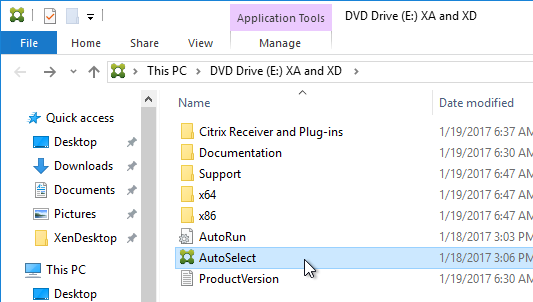
- On the right, click Citrix Director.
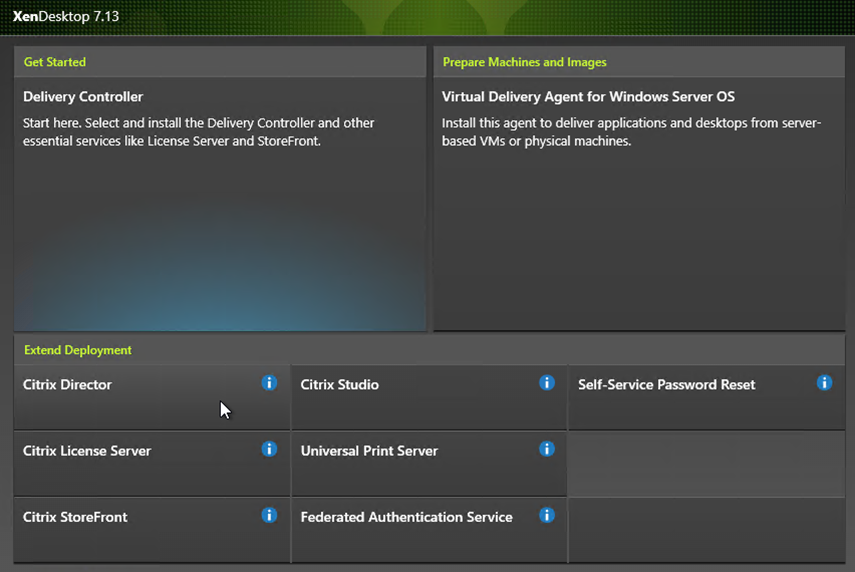
- In the Licensing Agreement page, select I have read, understand, and accept the terms, and click Next.
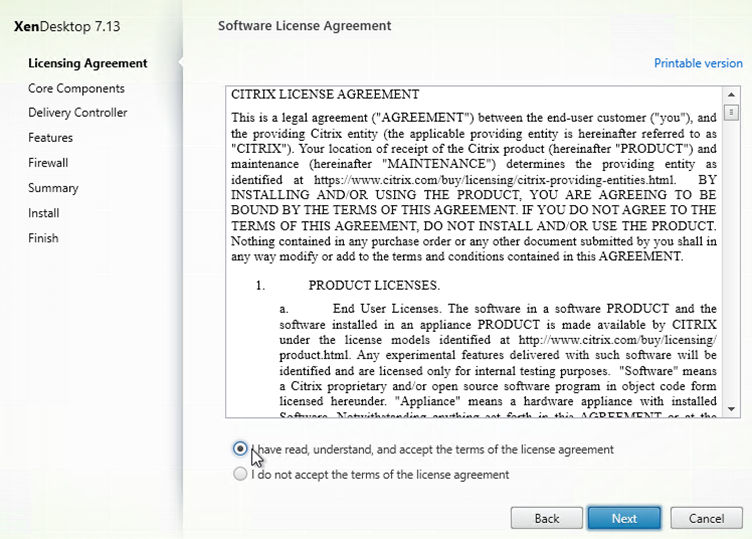
- In the Core Components page, click Next.
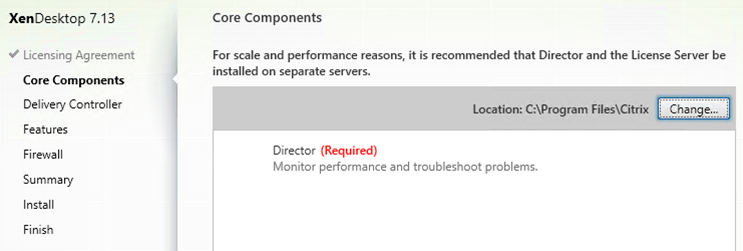
- In the Delivery Controller page, it will ask you for the location of one Controller in the farm. Only enter one Controller per farm. If you have multiple Director servers, each Director server can point to a different Controller in the farm. From Citrix Docs: Director automatically discovers all other Controllers in the same Site and falls back to those other Controllers if the Controller you specified fails. Click Test Connection, and then click Add.

- In the Features page, click Next.
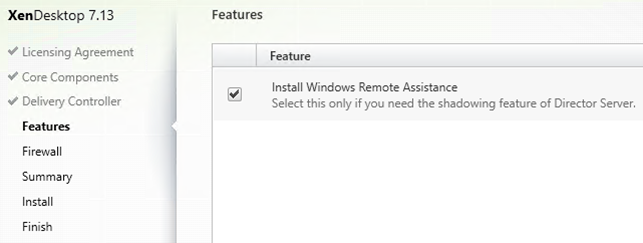
- In the Firewall page, click Next.
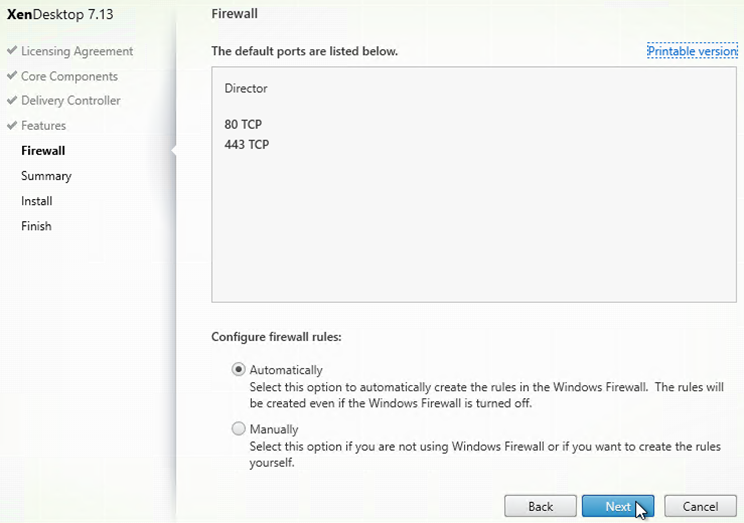
- In the Summary page, click Install.
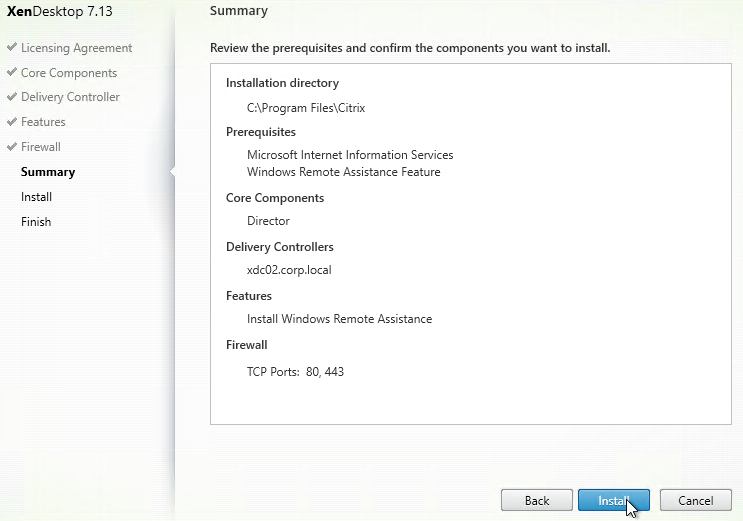
- In the Finish page, click Finish.
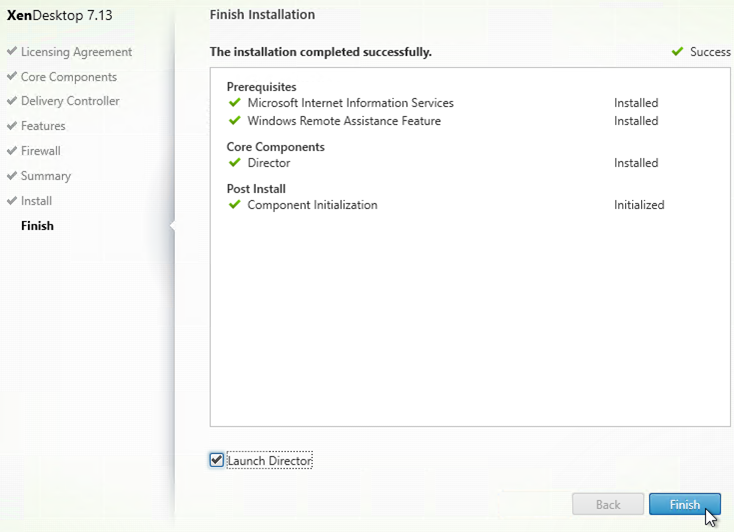
- In IIS Manager, go to Default Web Site > Director > Application Settings, find Service.AutoDiscoveryAddresses, and make sure it points to one Controller in the farm, and not to localhost. From Citrix Docs: Director automatically discovers all other Controllers in the same Site and falls back to those other Controllers if the Controller you specified fails.
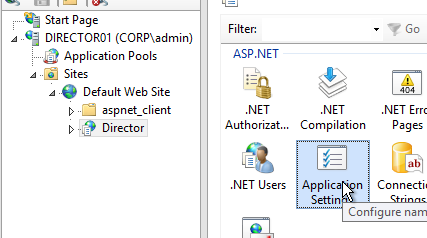
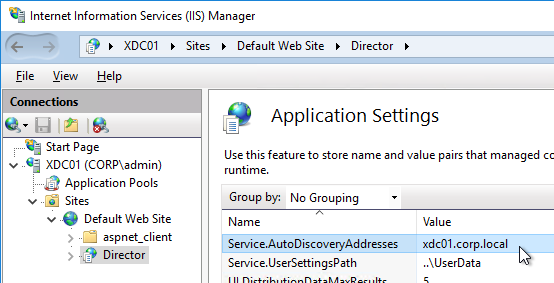
- If you built multiple Director servers, use NetScaler to load balance them.
- If you are upgrading Director, run C:\inetpub\wwwroot\Director\tools\DirectorConfig.exe /upgrade to complete the upgrade process.
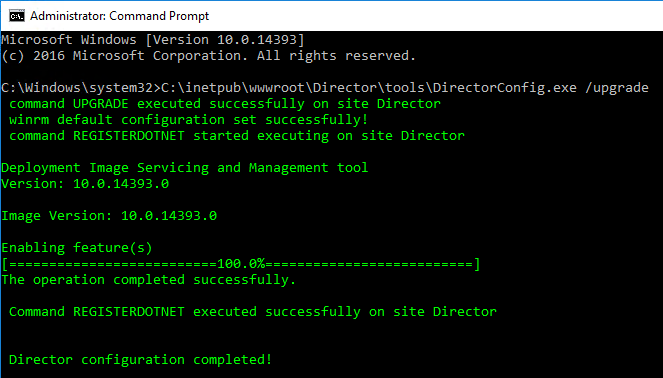
- For info on the new monitoring features in Director 7.13 and older, see Use Director below.
Director Spinning Circle
If after login the spinning circle doesn’t go away:
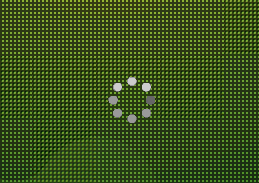
Do the following to fix it:
- Edit the file C:\inetpub\wwwroot\Director\web.config using an elevated text editor.
- Search for <serviceHostingEnvironment (line 273).
- Add the following attribute:
multipleSiteBindingsEnabled="true"
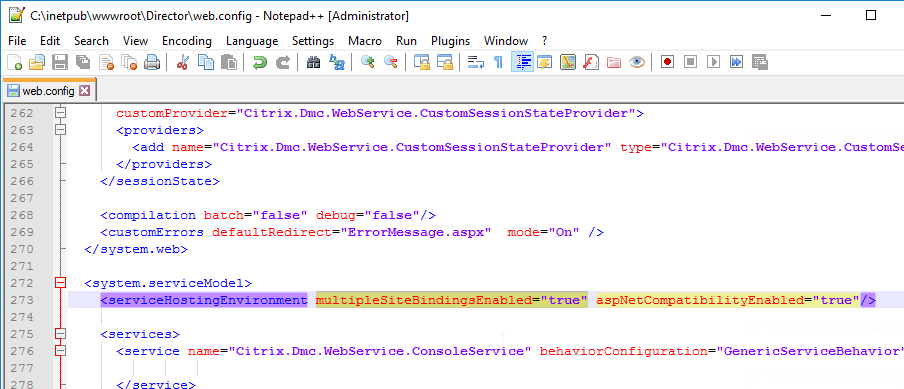
Also see CTX202564 Citrix Director Becomes Unresponsive after Submitting the Credentials when IIS X-Frame-Options is enabled
Director Tweaks
Prepopulate the domain field
From http://www.xenblog.dk/?p=33: On the Controllers having the Director role installed, locate and edit the ‘LogOn.aspx’ file. By default you can find it at C:\inetpub\wwwroot\Director\Logon.aspx
In line 450 you will have the following. To find the line, search for ID=”Domain”. Note: onblur and onfocus attributes were added in newer versions of Director.
<asp:TextBox ID="Domain" runat="server" CssClass="text-box" onfocus="showIndicator(this);" onblur="hideIndicator(this);"></asp:TextBox>
In the ID=”Domain” element, insert a Text attribute and set it to your domain name. Don’t change or add any other attributes. Save the file.
<asp:TextBox ID="Domain" runat="server" Text="Corp" CssClass="text-box" onfocus="showIndicator(this);" onblur="hideIndicator(this);"></asp:TextBox>
This will prepopulate the domain field text box with your domain name and still allow the user to change it, if that should be required. Note: this only seems to work if Single Sign-on is disabled.
Session timeout
By default the idle time session limit of the Director is 245 min. If you wish to change the timeout, here is how to do it.
- Log on to the Director Server as an administrator
- Open the ‘IIS Manager’
- Browse to ‘SitesDefault Web SiteDirector’ in the left hand pane.
- Open ‘Session State’ in the right hand pane
- Change the ‘Time-out (in minutes)’ value under ‘Cookie Settings’
- Click ‘Apply’ in the Actions list
SSL Check
From http://euc.consulting/blog/citrix-desktop-director-2-1: If you are not securing Director with an SSL certificate you will get this error at the logon screen.

To stop this:
- Log on to the Director Server as an administrator
- Open the ‘IIS Manager’
- Browse to ‘SitesDefault Web SiteDirector’ in the left hand pane.
- Open ‘Application Settings’ in the right hand pane
- Set UI.EnableSslCheck to false.
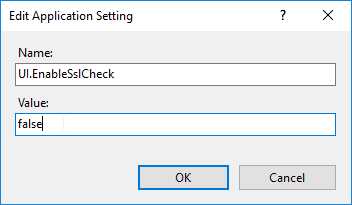
Disable Activity Manager
From Disable the visibility of running applications in the Activity Manager in Advanced Configuration at Citrix Docs: By default, the Activity Manager in Director displays a list of all the running applications and the Windows description in the title bars of any open applications for the user’s session. This information can be viewed by all administrators that have access to the Activity Manager feature in Director. For Delegated Administrator roles, this includes Full administrator, Delivery Group administrator, and Help Desk Administrator.
To protect the privacy of users and the applications they are running, you can disable the Applications tab from listing running applications.
- On the VDA, modify the registry key located at HKLM\Software\Citrix\Director\TaskManagerDataDisplayed. By default, the key is set to 1. Change the value to 0, which means the information will not be displayed in the Activity Manager.
- On the server with Director installed, modify the setting that controls the visibility of running applications. By default, the value is true, which allows visibility of running applications in the Applications Change the value to false, which disables visibility. This option affects only the Activity Manager in Director, not the VDA. Modify the value of the following setting:
UI.TaskManager.EnableApplications = false
Large Active Directory / Multiple Forests
From CTX133013 Desktop Director User Account Search Process is Slow or Fails: By default, all the Global Catalogs for the Active Directory Forest are searched using Lightweight Directory Access Protocol (LDAP). In a large Active Directory environment, this query can take some time or even time out.
If multiple forests, see Citrix Blog Post Using Citrix Director in a MultiForest Environment.
- In Information Server (IIS) Management, under the Desktop Director site, select Application Settings and add a new value called Connector.ActiveDirectory.ForestSearch. Set it to False. This disables searching any domain except the user’s domain and the server’s domain.
- To search more domains, add the searchable domain or domains in the Connector.ActiveDirectory.Domains field.
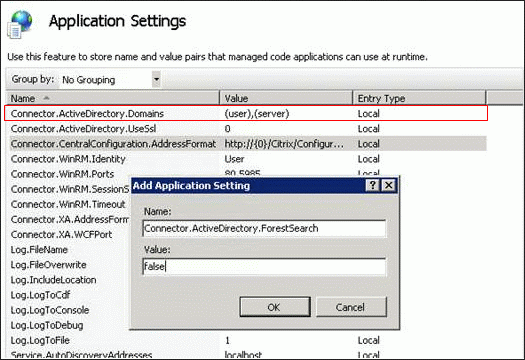
Site Groups
From Citrix Blog Post Citrix Director 7.6 Deep-Dive Part 4: Troubleshooting Machines:
If there are a large number of machines, the Director administrator can now configure site groups to perform machine search so that they can narrow down searching for the machine inside a site group. The site groups can be created on the Director server by running the configuration tool via command line by running the command:
C:\inetpub\wwwroot\Director\tools\DirectorConfig.exe /createsitegroups
Then provide a site group name and IP address of the delivery controller of the site to create the site group.
Director Configuration Script 💡
Johan Greefkes at Script for configuring Director at Citrix Discussions was kind enough to provide a script that does the following:
- Sets the XenDesktop Controllers that Director communicates with
- Disables SSL Check
- Sets Logon.aspx file to default to a domain name
- Adds a footer that displays the name of the Director server
Director – Saved Filters
From Scott Osborne and Jarian Gibson at Citrix Discussions: In Director, you can create a filter and save it.


The saved filter is then accessible from the Filters menu structure.

The saved filters are stored on each Director server at C:\Inetpub\wwwroot\Director\UserData. Each user has their own saved filters. The saved filters are not replicated across Director servers.

You can instead configure multiple Director servers to store the filters on a shared UNC path: (h/t CTP Jarian Gibson)
- Create and share a folder (e.g. DirectorData).
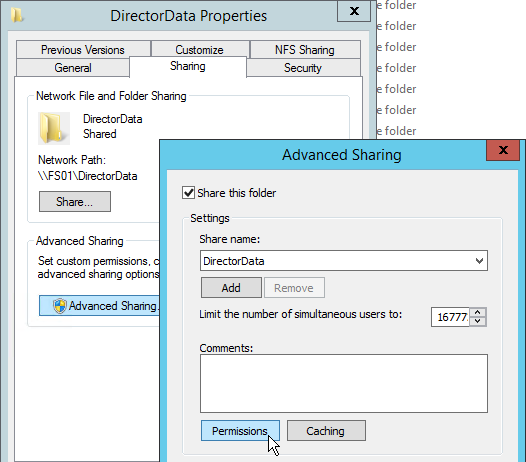
- The Director server computer accounts need Modify permission to the share.
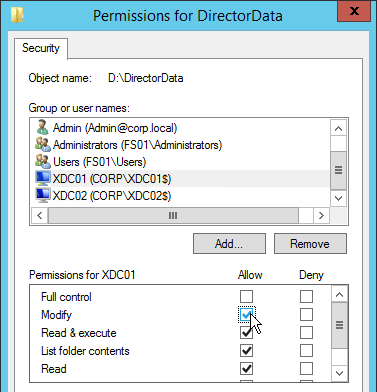
- On each Director server, run IIS Manager.
- Go to Sites > Default Web Site > Director. In the middle, double-click Application Settings.
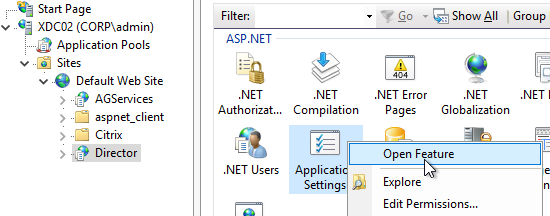
- Change the Service.UserSettingsPath setting to the UNC path of the new share.
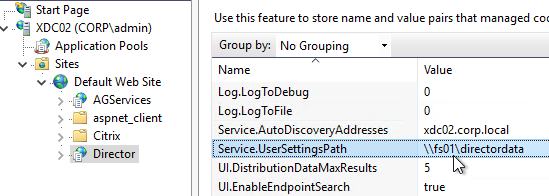
- Repeat this on other load balanced Director servers.
Director and HDX Insight
You can connect Director to NetScaler Management & Analytics System (NetScaler MAS) or Citrix Insight Center to add Network tabs to Director’s Trends and Machine Details views. Citrix Blog Post Configure Director with NetScaler Management & Analytics System (MAS).

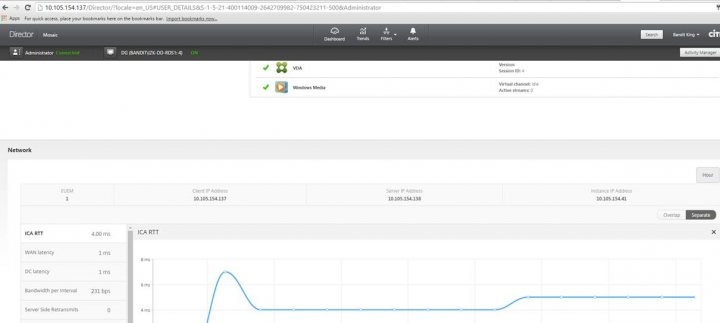
Director and Self-Service Password Reset (SSPR)
If you have XenApp/XenDesktop Platinum Edition, it’s possible to install SSPR on the Director server. See George Spiers Citrix Self-Service Password Reset for a detailed implementation guide.
However this might break Director, and all you will see is a spinning circle.

To fix it, in IIS Manager (inetmgr), edit the bindings of the Default Web Site, and Remove the HTTP 8080 binding. Or implement the multisitebinding fix.
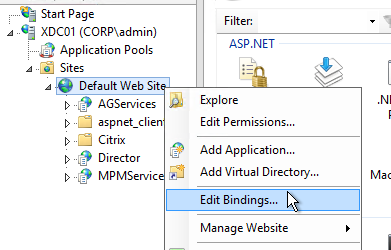

More info at Citrix Discussions Installing SSPR 1.0 appears to have broken Director 7.11 on same server.
Director Grooming
If XenDesktop is not Platinum Edition, then all historical Director data is groomed at 30 days.
For XenDesktop/XenApp Platinum Edition, by default, most of the historical Director data is groomed at 90 days. This can be adjusted up to 367 days by running a PowerShell cmdlet.
- On a XenDesktop Delivery Controller, run PowerShell and run asnp Citrix.*

- Run Get-MonitorConfiguration to see the current grooming settings.

- Run Set-MonitorConfiguration to change the grooming settings.

Director Single Sign-on
You can configure Director to support Integrated Windows Authentication (Single Sign-on). Note: there seem to be issues when not connecting from the local machine or when connecting through a load balancer.
- Run IIS Manager. You can launch it from Server Manager (Tools menu), or from the Start Menu, or by running inetmgr.
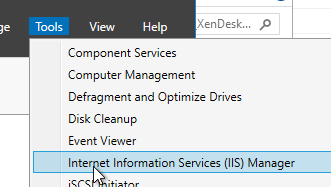
- On the left, expand Sites, expand Default Web Site, and click Director.
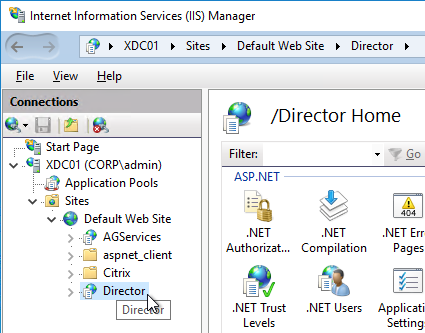
- In the middle, double-click Authentication in the IIS section.
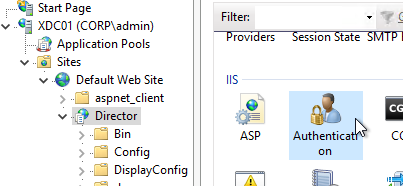
- Right-click Windows Authentication, and Enable it.
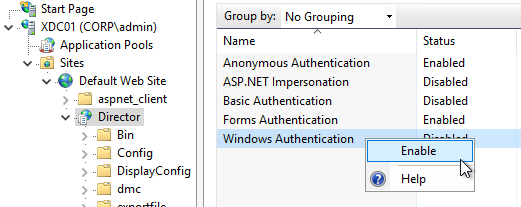
- Right-click Anonymous Authentication, and Disable it.

- Pass-through auth won’t work from another computer until you set the http SPN for the Director server. See Director 7.7 Windows Authentication not working with NS LB at Citrix Discussions.

- If Director is not installed on a Controller then you’ll need to configure Kerberos delegation.
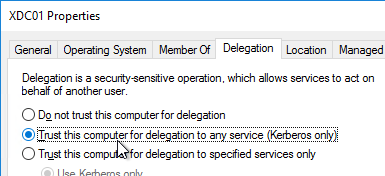
- If you are load balancing Director then additional config is required. See Director 7.7 Windows Authentication not working with NS LB at Citrix Discussions for more info.
- Create an AD service account that will be used as the Director’s ApplicationPoolIdentity.
- Create SPN and link it to the service account.
setspn -S http/loadbalanced_URL domain\user
- Trust the user account for delegation to any service (Kerberos only) (trust the Director servers for delegation is not necessary in this case). You have to create the SPN before you can do this step.
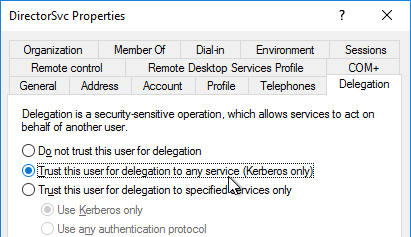
- In IIS manager, on the Application Pools (Director), specify the Identity as user we have created in step 1.
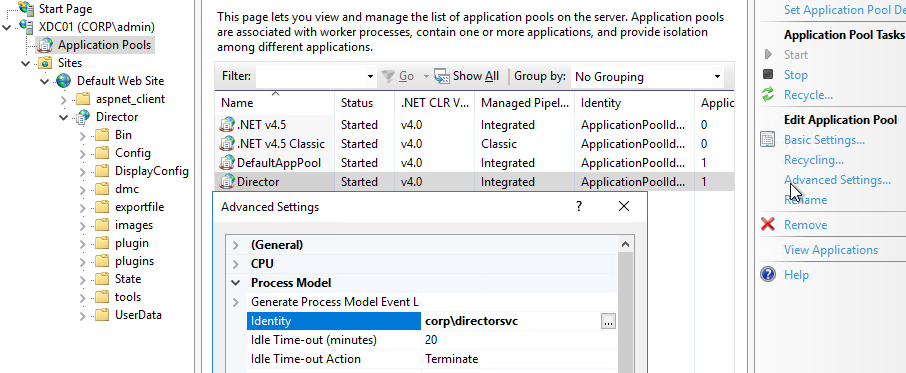
- In IIS manager, select Default Web Site and open the Configuration Editor.
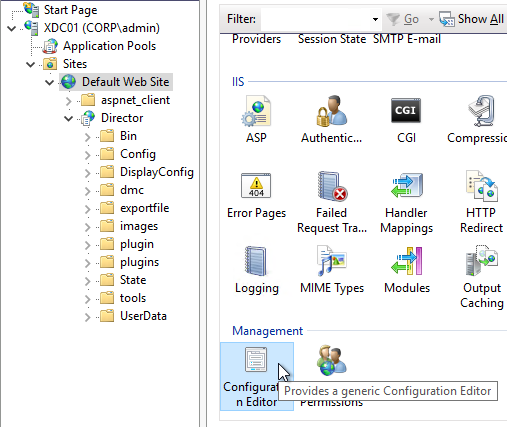
- Use the drop-down to navigate to the following section:
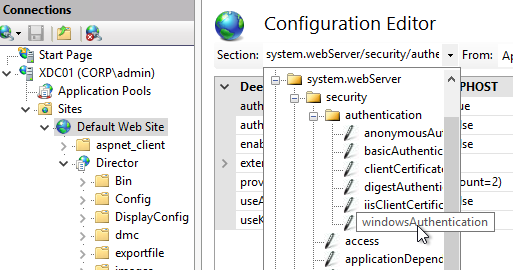
system.webServer/security/authentication/windowsAuthentication
- Set useAppPoolCredentials = True and useKernelMode = False. Click Apply on the top right.
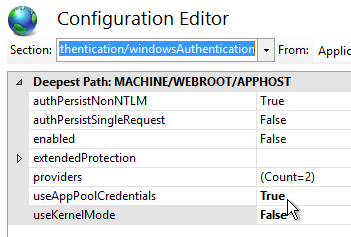
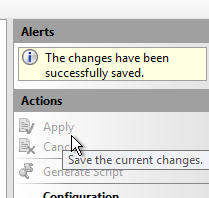
- When you connect to Director you will be automatically logged in. You can change the login account by first logging off.
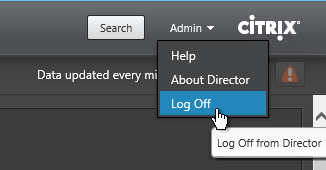
- Then change the drop-down to User credentials.
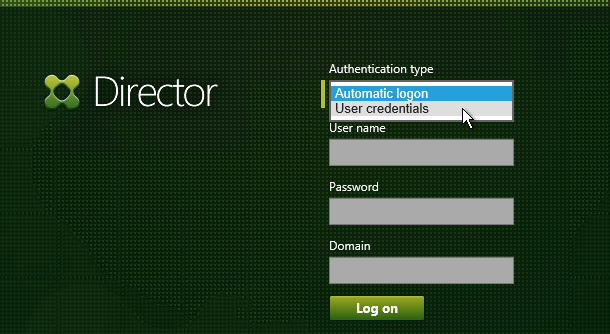
Director – Multiple XenDesktop Sites
- Run IIS Manager. You can launch it from Server Manager (Tools menu) or from the Start Menu, or by running inetmgr.
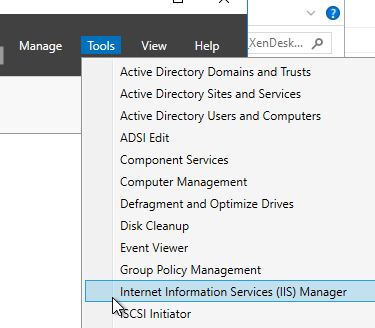
- On the left, expand Sites, expand Default Web Site, and click Director.
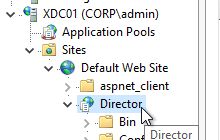
- In the middle pane, double-click Application Settings.
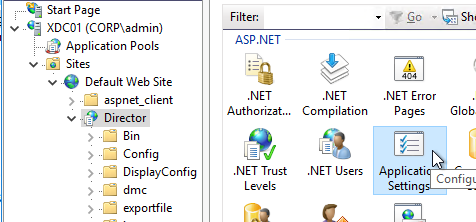
- Find the entry for Service.AutoDiscoveryAddresses, and double-click it.
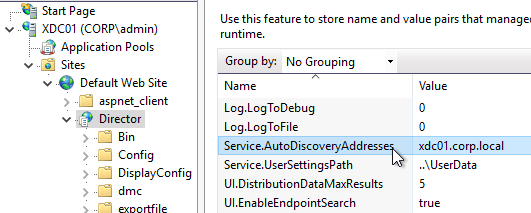
- If Director is installed on a Controller, localhost should already be entered.
- Add a comma, and the NetBIOS name of one of the controllers in the 2nd XenDesktop Site (farm). Only enter one Controller name. If you have multiple Director servers, you can point each Director server to a different Controller in the 2nd XenDesktop Site (farm). From Citrix Docs: Director automatically discovers all other Controllers in the same Site and falls back to those other Controllers if the Controller you specified fails.
Director Process Monitoring
Director 7.11 and newer have Process Monitoring, which is detailed in Citrix Blog Post Citrix Director: CPU, Memory Usage and Process Information.
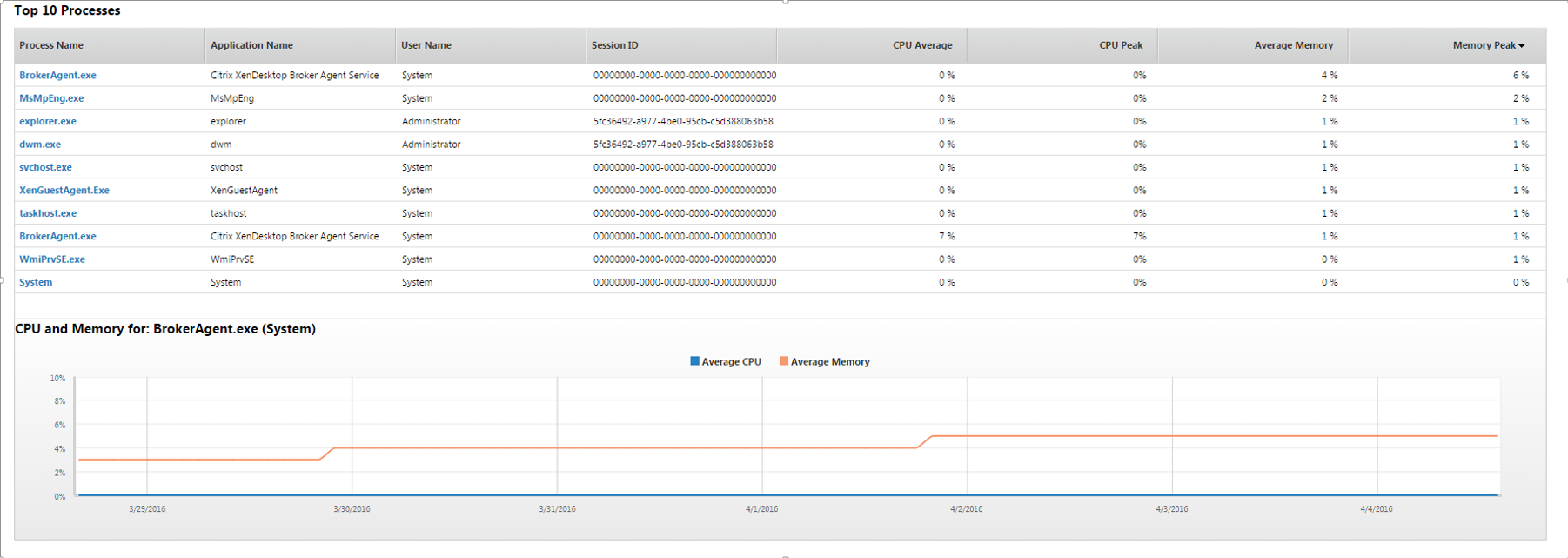
Process Monitoring is disabled by default. To enable it, configure the Enable process monitoring setting in a Citrix Policy. For Citrix Policies in a GPO, find this setting in the computer half of the GPO. Note: this setting could significantly increase the size of the Monitoring database.
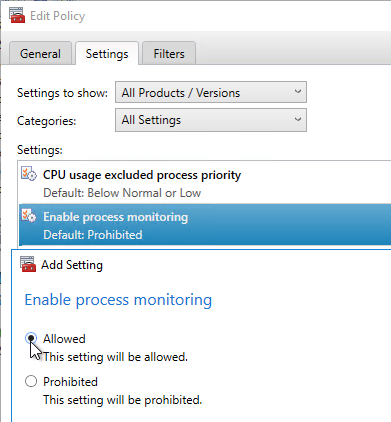
Director Alerts and Notifications
Director supports alert conditions and email notifications. This feature requires XenApp/XenDesktop to be licensed with Platinum Edition. See Citrix Blog Post Configuring & Managing Alerts and Notifications Using Director for more information.
Director 7.11 and newer have CPU, Memory, and ICT RTT alerts. Citrix Blog Post 7 New Categories in Director for Proactive Notifications & Alerts
To configure alerts:
- While logged into Director, at the top of the page, click the Alerts button.

- Switch to the Email Server Configuration tab.
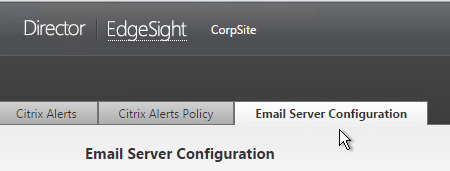
- Enter your SMTP information, and click Send Test Message. Then click Save.
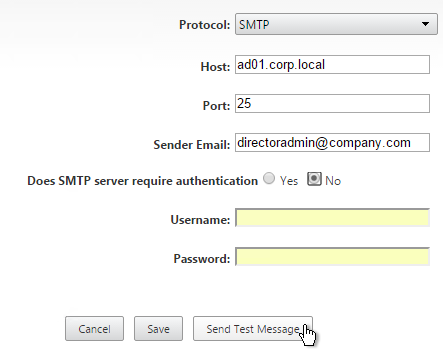
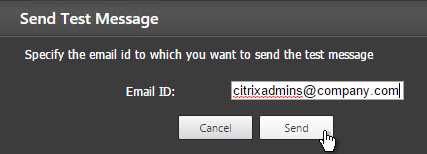
- Switch to the Citrix Alerts Policy tab.
- There are four high-level categories of alerts: Site Policy, Delivery Group Policy, Server OS Policy, and User Policy. Click whichever one you want to configure.
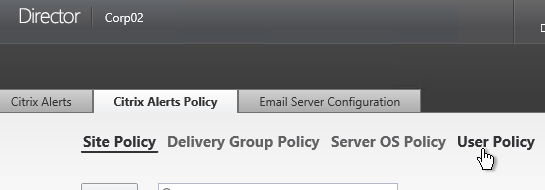
- Then click Create.
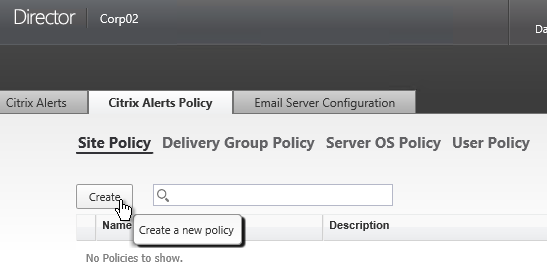
- Give the alert a name.
- On the bottom left, select a condition and enter thresholds.
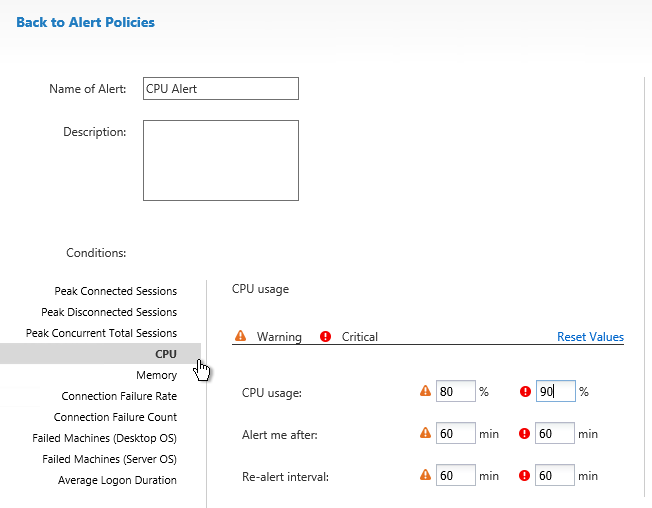
- On the bottom right, in the Notifications preferences section, click Add.
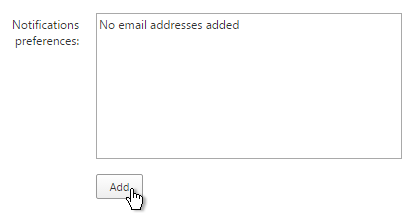
- Enter an email address, and click Add.

- Click Save when done. Feel free to create more alerts and notifications.

- For Server OS and User Policy, there are new ICA RTT alerts. See Citrix Blog Post 7 New Categories in Director for Proactive Notifications & Alerts for details on the new alerts in 7.11 and newer.
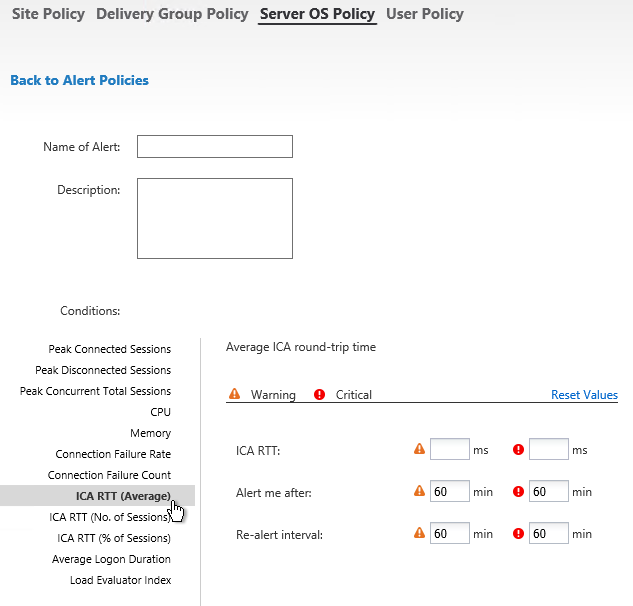
- In Director 7.12 and newer, you can configure alerts to generate an SNMP trap. This is configured in PowerShell as described at Configure alerts policies with SNMP traps at Citrix Docs.
Set-MonitorNotificationSnmpServerConfiguration #see Docs for parameter details Set-MonitorNotificationPolicy -IsSnmpEnabled $true -Uid <Policy ID>
- Citrix has an experimental Desktop Notification Tool. See Citrix Blog Post Desktop Notification Tool For Citrix XenDesktop.

Director Alerts can be configured with a WebHook that allows Octoblu to perform actions when a Director Alert occurs. See Configure alerts policies with Octoblu webhooks at Citrix Docs for details.
Set-MonitorNotificationPolicy –Uid 5 –Webhook <Webhook URL>
Director – SCOM Integration
Director 7.8 and newer can display alerts from System Center Operations Manager 2012 R2. This feature requires XenApp/XenDesktop Platinum Edition.
- See Configure SCOM integration at Citrix Docs for detailed configuration instructions. Also see Marius Sandbu Integrating Citrix XenDesktop 7.7 and System Center Operations Manager.
- If Director server or System Center Operations Manager server is 2008 R2, then login to the 2008 R2 server, open PowerShell and run Enable-PSRemoting. Yes to everything. This is not needed on Windows Server 2012 R2 servers.
- On Director server, run C:\inetpub\wwwroot\Director\tools\DirectorConfig.exe /configscom
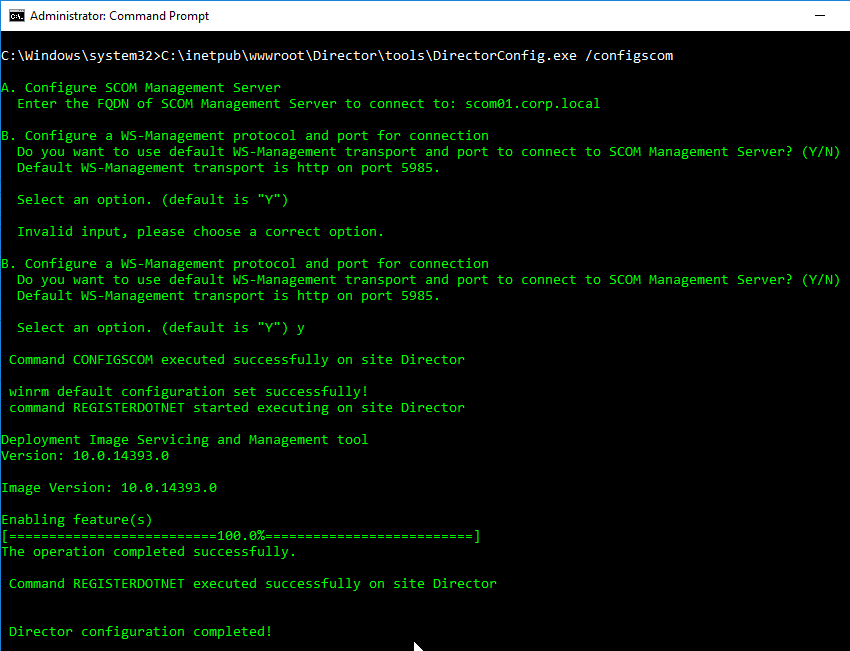
- FYI, the DirectorConfig.exe /configscom command enables the following features on the Director server: /FeatureName:IIS-NetFxExtensibility45 /FeatureName:IIS-ASPNET45 /FeatureName:WCF-HTTP-Activation45
- FYI, the System Center Operations Manager server is listed in IIS Manager at Default Web Site > Director > Application Settings (middle pane) > Connector.SCOM.ManagementServer.
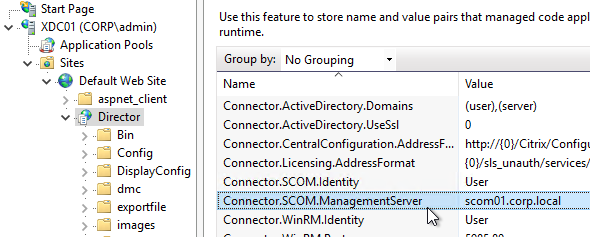
- On the System Center Operations Manager server, edit Remote Management Users local group, and add Citrix Admins, and other Director users.
- In System Center Operations Manager Console, go to Administration > User Roles, and edit Operations Manager Operators. Add the Citrix Admins, and other Director users.
- See Citrix Blog Post SCOM Alerts in Citrix Director for information on how to view System Center Operations Manager alerts in Director.
Director – Custom Reports
In Director 7.12 and newer, in the Trends view, there’s a Custom Reports tab that guides you through creating a custom OData Query. This tab only appears if you have XenApp/XenDesktop Platinum Edition.
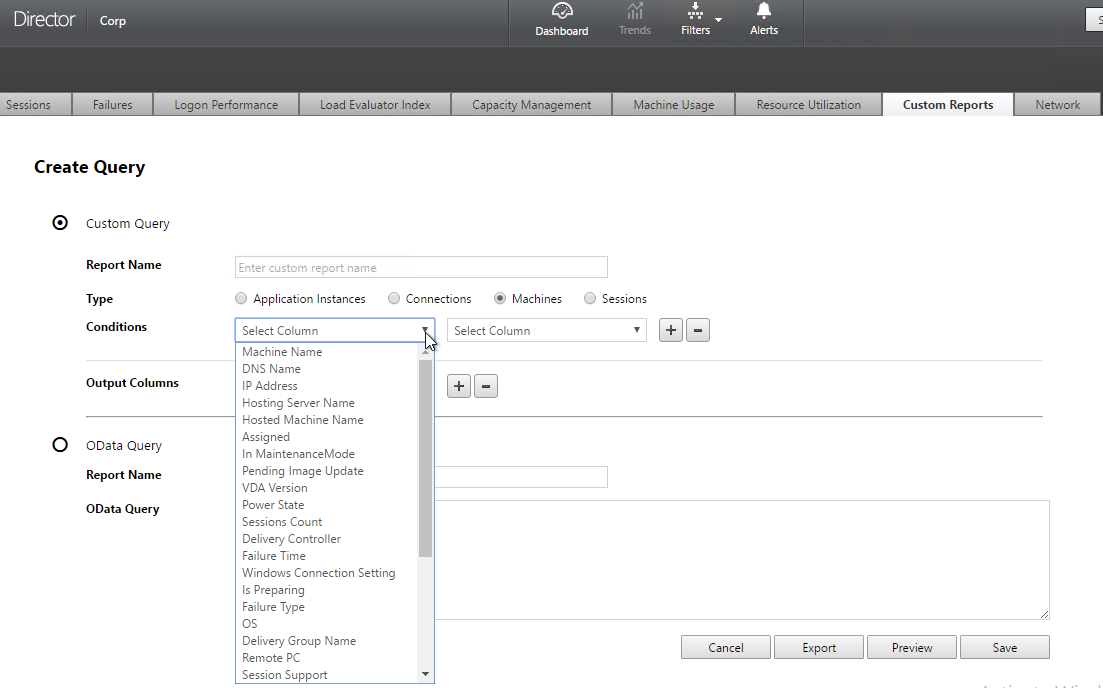
The Monitoring database contains more data than is exposed in Director. To view this data, the Monitoring service has an OData Data Feed that can be queried.
- You can use Excel to pull data from the OData Data feed. See Citrix Blog Post – Citrix Director – Analyzing the Monitoring Data by Means of Custom Reports. This particular blog post shows how to use an Excel PivotChart to display the connected Receiver versions.
- Also see Alexander Ollischer Citrix XenDesktop 7.x – Query Citrix Receiver Versions connecting to your environment – XLS Report 💡
- Citrix CTX211428 Using Excel to Report on Desktop Director Data uses Power Pivot.
- Or for Linqpad, see Citrix Blog Post – Creating Director Custom reports for Monitoring XenDesktop using Linqpad
- CTA David Ott XenDesktop Usage Report shows that querying OData can be slow and it’s sometimes faster to query the actual Monitoring database. Updated Report.
Use Director
See Monitor deployments at Citrix Docs.
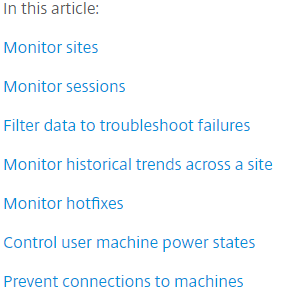
Citrix Director 7.13 and newer have an Application Instances tab on the Filters page that lets you filter published application sessions based on Session Idle Time (RDS sessions only), Application Name, and all other existing fields, like machine name, and so on. Requires Director 7.13, Controller 7.13, VDA 7.13, and Platinum Edition licensing. See Citrix Blog Post Monitoring Idle Applications and Sessions in Citrix Director. See Troubleshooting applications at Citrix Docs.
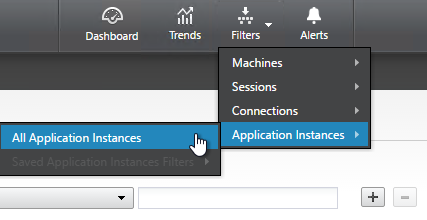
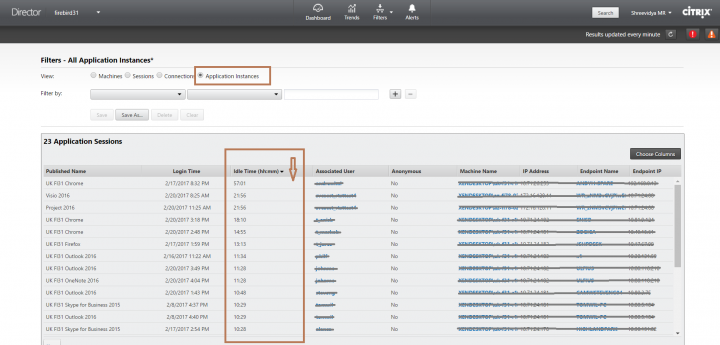
If idle time column shows n/a, then you need to wait 10-15 minutes.
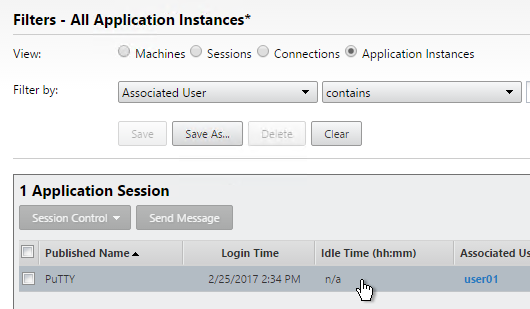
In Director 7.13 and newer, the Session Details panel can show if Enlightened Data Transport (EDT, aka HDX on UDP) is enabled in the user’s session. See Citrix Blog Post HDX Adaptive Transport Protocol Monitoring via Director.
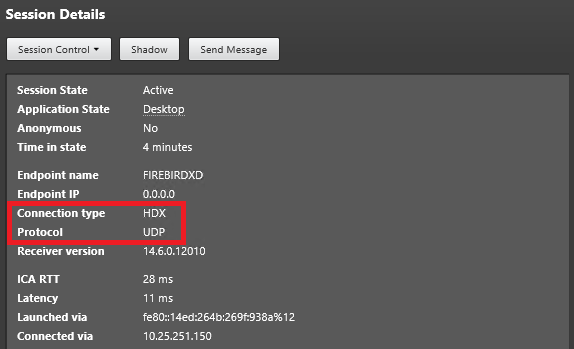
George Spiers has a comprehensive guide of all Director 7.12 features at http://www.jgspiers.com/citrix-director/.
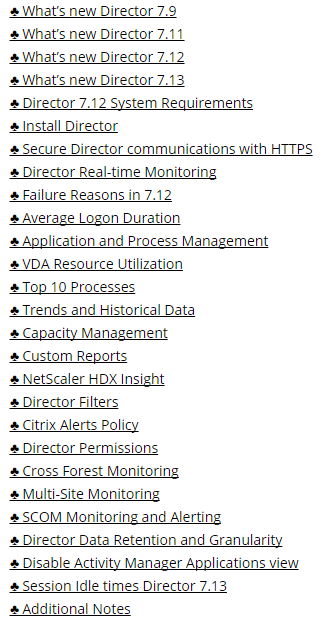
Director 7.12 and newer have Connection Failure Details, which is detailed in Citrix Blog Post Director 7.12: Easier Troubleshooting of Machine & Connection Failures.
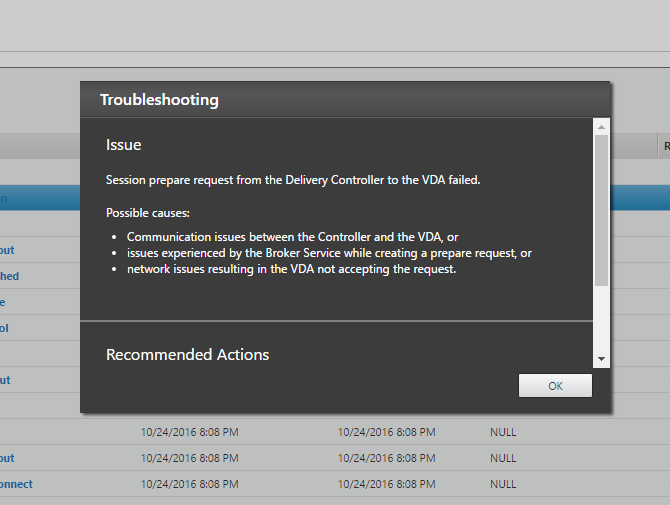
Director 7.11 and newer have Process Monitoring, which is detailed in Citrix Blog Post Citrix Director: CPU, Memory Usage and Process Information.

Director 7.9 and newer have Logon Duration improvements.
Citrix Blog Post Interactive Session of Logon Duration in Citrix Director – Explained: Interactive Session Duration = Desktop Ready Event Timestamp (EventId 1000 on VDA) – User Profile Loaded Event Timestamp (EventId 2 on VDA). More details in the Blog Post.

Citrix Blog Post Director 7.6 Failure Reasons Demystified lists possible failure reasons behind an Unregistered alert, and the true meaning of failure reasons such as Connection Refused and Communication Error. It details each failure reason, defines the meanings of these failures, and lists action items that serve as a starting point for troubleshooting the specific scenario. The list is based on Director 7.6.300.
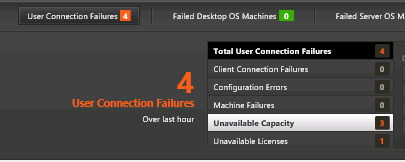
Carl, Thanks for all the information, it was very detailed. It didn’t get my Citrix Director to work with SSO immediately, but I kept hammering with different settings until I found a combination that worked.
My Director is NOT installed on a controller, which you covered. I am not currently load balancing director either. I made so many changes I’m not sure I can remember them all, but if anyone is trying to setup SSO and wants me to check a setting in my environment, I would be happy to help, since this was a monumental pain for me.
After following the guide, The last setting I made that helped, was changing the appPool Identity from a service account (that probably wasn’t SPN correctly) to LocalSystem for Director.
CArl, is there any possibilite to select the columns and save like a default settings?
Hi Carl,
I’ve setup Director SSO based on your instructions above. Using Netscaler to LB Director URL, have included 302 monitor as well.
However it is still prompting to login when I hit the Director LB URL. On the 2 x Controllers where Director is running from, SSO works fine when running from these servers. Anything else to look for?
Never mind I have it working now. I had the Controller SPN accounts setup as well, unassigned the SPN Server Accounts, then only added setspn -S http/loadbalanced_URL domain\user. All good now
Hello
How do I remove old Citrix VDAs already deleted from the environment? Even after deleting from Machine Catalog, it continues to be shown in the Director. Do I really have to wait 90 days?
I have a multi-site environment that I’ve added one Delivery Controller from each Domain in Default Web Site > Director > Application Settings, find Service.AutoDiscoveryAddresses. Only 5 of the 11 show up when I log into the master. I’m not sure what else could be missing.
Hi Carl,
Thank you for all that good posted information. Here is one questions..what is the easiest way to customize the Cirix Director logon page. The default one looks like the Green Bubble
Carl, Does Xenapp 7.13 have the ability to send emailed reports?
There’s nothing built in. But CTP Jarian Gibson mentioned: “the reports function does show the odata piece so you could use that to create scripts for emailed reports”.
Also see https://www.citrix.com/blogs/2015/04/21/citrix-director-tool-automated-daily-and-weekly-custom-report-emails/. I’m not sure if this works in newer Director.
Thanks. I am on 7.8 at the moment and am planning on upgrading. This functionality would require upgrading to Platinum correct?
Carl,
Looking for some help with an issue with Director 7.13 setting up CAC authentication
Hi Carl,
For Director use in multi-site environment where one or more Director servers need to access the other sites, it’s mandatory to add also Service.MultiSite = true in the IIS Manager > Director server –
https://support.citrix.com/article/CTX136165.
In large environments, Director might crash without the Service.MultiSite config set to true.
Cheers!
What is the best practice regarding reboot interval for a Xendesktop environment? Is it once a week? We have an old image based on Windows 7 x86.
I typically see Remote Desktop Session Host VDAs rebooted weekly.
For virtual desktops, if non-persistent, they reboot on every logoff. If persistent, usually whenever patches are deployed.
Thanks for the respons Carl. We have non-persistent desktops. Do you mean as in logoff every day? Because users have the option to disconnect.
When the user logs off, the machines reboot. You can configure session timeouts so the users are logged off when idle or disconnected.
oh ok. We now use a rebootscript that keeps the Win7 x86 VDI alive for a week. I think this causes some issues. Is there some kind of best practice based on OS version?
Do users need to stay logged in for 7 days? Typically you want them out of the machine so somebody else can use it. Once they logoff, the desktop will reboot.
For RDSH, weekly is typical.
Or reboot whenever you update your image (at least monthly, but some do weekly).
Carl thanks for the explanation on upgrade and why Director would not launch. I had a case open for this, saw your blog on it and fixed my issue in two minutes. This part- In IIS Manager, go to Default Web Site > Director > Application Settings, find Service.AutoDiscoveryAddresses, and make sure it points to one Controller in the farm, and not to localhost. From Citrix Docs: Director automatically discovers all other Controllers in the same Site and falls back to those other Controllers if the Controller you specified fails.